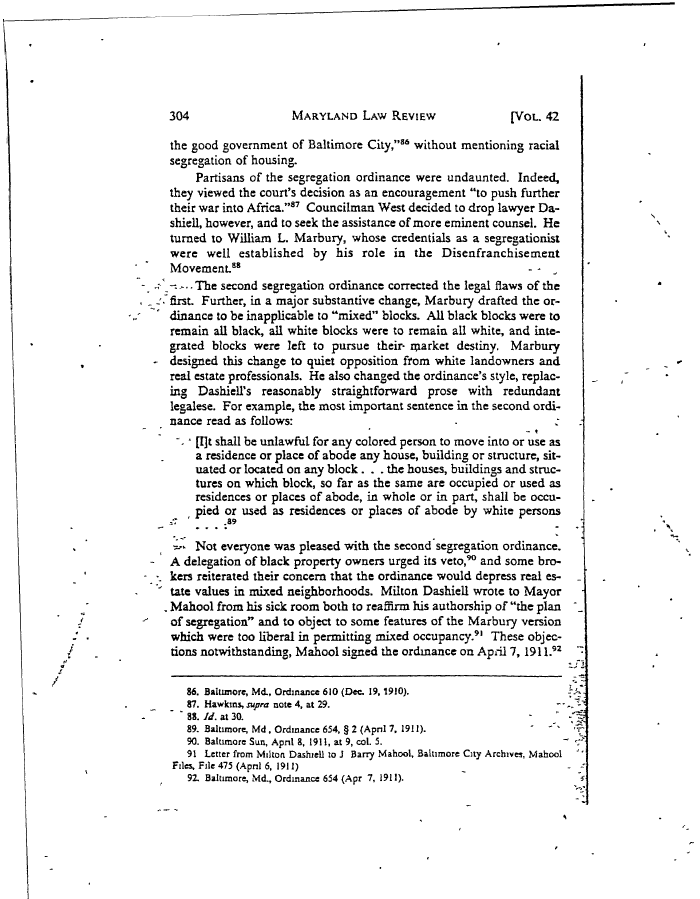 |
||||
|
Garrett Power, Apartheid Baltimore Style: The Residential Segregation Ordinances of 1910-1913, Maryland Law Review, 42 (1983) , Image No: 17 Enlarge and print image (60K) << PREVIOUS NEXT >> |
 |
||||
|
Garrett Power, Apartheid Baltimore Style: The Residential Segregation Ordinances of 1910-1913, Maryland Law Review, 42 (1983) , Image No: 17 Enlarge and print image (60K) << PREVIOUS NEXT >> |
| 304 MARYLAND LAW REVIEW {VOL. 42 the good government of Baltimore City,86 without mentioning racial segregation of housing. Partisans of the segregation ordinance were undaunted. Indeed, they viewed the court's decision as an encouragement "to push further their war into Africa."87 Councilman West decided to drop lawyer Da- shiell, however, and to seek the assistance of more eminent counsel. He turned to William L. Marbury, whose credentials as a segregationist were well established by his role in the Disenfranchisement Movement.88 - „ The second segregation ordinance corrected the legal flaws of the first. Further, in a major substantive change, Marbury drafted the or- dinance to be inapplicable to "mixed" blocks. All black blocks were to remain all black, all white blocks were to remain all white, and inte- grated blocks were left to pursue their- market destiny. Marbury designed this change to quiet opposition from white landowners and real estate professionals. He also changed the ordinance's style, replac- ing Dashiel's reasonably straightforward prose with redundant legalese. For example, the most important sentence in the second ordi- nance read as follows: It shall be unlawful for any colored person to move into or use as a residence or place of abode any house, building or structure, sit- uated or located on any block. . . the houses, buildings and struc- tures on which block, so far as the same are occupied or used as residences or places of abode, in whole or in part, shall be occu- pied or used as residences or places of abode by white persons Not everyone was pleased with the second segregation ordinance. A delegation of black property owners urged its veto,90 and some bro- kers reiterated their concern that the ordinance would depress real es- tate values in mixed neighborhoods. Milton Dashiell wrote to Mayor Mahool from his sick room both to reaffirm his authorship of "the plan of segregation" and to object to some features of the Marbury version which were too liberal in permitting mixed occupancy.91 These objec- tions notwithstanding, Mahool signed the ordinance on April 7,1911.92 86. Baltimore, Md, Ordinance 610 (Dec. 19,1910). 87. Hawkins, supra note 4, at 29. 88. Id. at 30. 89. Baltimore, Md, Ordinance 654, § 2 (Apnl 7, 1911). 90. Baltimore Sun, Apnl 8, 1911, at 9, col. 5. 91 Letter from Milton Dashiell to J Barry Mahool, Baltimore City Archives, Mahool Files, File 475 (April 6. 1911) 92. Baltimore, Md., Ordinance 654 (Apr 7, 1911). |